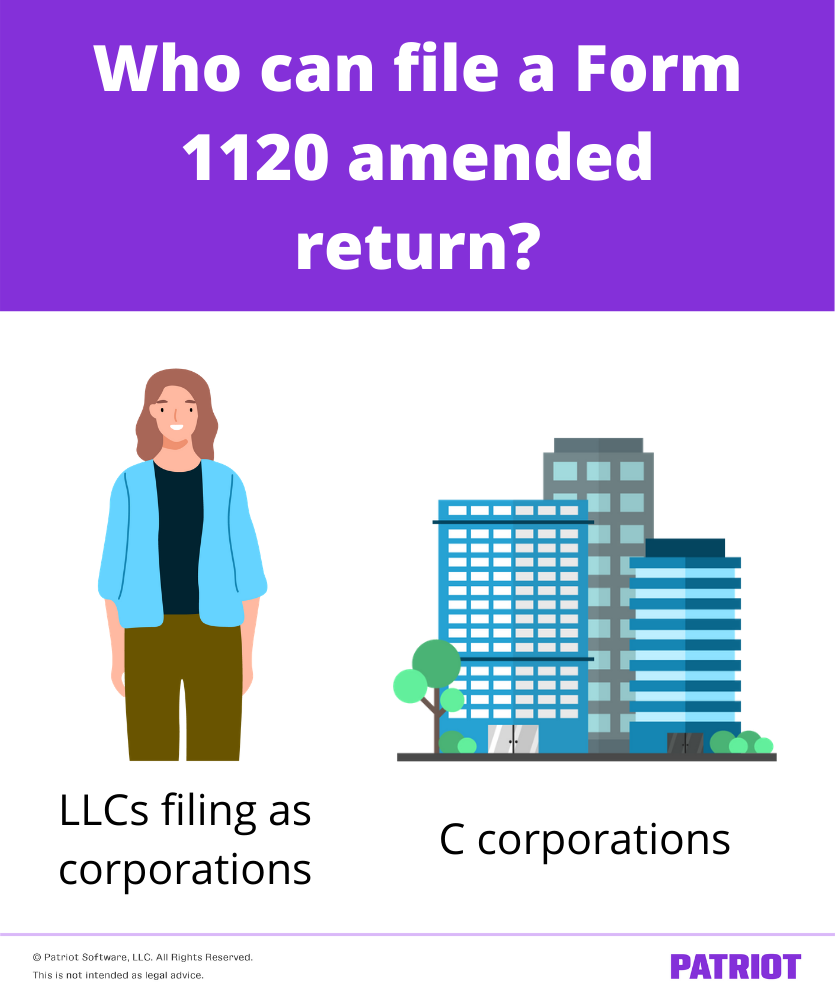Mistakes are part of being a business owner. At one point or another, you may make a mistake on a form, such as your business income tax return. If your business is structured as a C Corp or taxed as a corporation, you can use Form 1120X to amend your original return. Read on to learn all about Form 1120 amended return and how to use it to correct errors.
Form 1120 overview
Before you can learn about an 1120 amended return, you need to know what Form 1120 is. Form 1120, U.S. Corporate Income Tax Return, is the form incorporated businesses use to file income taxes for the year. Corporations must use Form 1120 to report things like income, gains, losses, deductions, and credits.
If your business is a corporation or files as one (e.g., LLCs filing as a corporation), you must file Form 1120. The form will tell you how much your business needs to pay in income taxes for the period.
Form 1120 amended return
So, what is a Form 1120 amended return? An amended Form 1120, also called Form 1120X, comes into play when you make a mistake on the corporate income tax return.
Form 1120X, Amended U.S. Corporation Income Tax Return, allows businesses to correct mistakes made on their already filed Form 1120.
You may need to file an amended Form 1120 if you forgot to include expenses or deductions on your originally filed form. Or, you may need to amend your form if you claimed a deduction you shouldn’t have.
Common Form 1120X questions
To learn more about Form 1120X, check out the answers to common questions below.
Who can file the form?
Again, only businesses that need to file Form 1120 can use Form 1120X. This includes:
- C corporations
- LLCs filing as a corporation
You may be wondering, Can S corporations file Form 1120X? Because S Corps don’t file Form 1120, they should not use Form 1120X for amended returns. Instead, they must use a Form 1120-S amended return.

What can’t you use Form 1120X for?
Do not use Form 1120X to:
- Apply for a quick refund of estimated tax
- Request IRS approval for a change in accounting method
- Obtain a tentative refund of taxes due to a net operating loss carryback, a net capital loss carryback, an unused general business credit carryback, or a claim of right adjustment under section 1341(b)(1)
According to the IRS, you can use the form to either:
- Correct a Form 1120 as originally filed
- Correct a Form 1120 later adjusted by an amended return, a claim for refund, or an examination
- Make certain elections after the prescribed deadline
What kind of information do you put on the Form 1120X?
The following information goes on Form 1120X:
- Business name and address
- EIN
- Income and deductions
- Payments and credits
- Tax due or overpayment
- Explanation of changes
- Signature
On your amended form, also provide information from your originally filed tax return, as well as new totals based on your new information.
Depending on what you are amending, you may also need to attach certain documents. For example, if your correction includes income, deductions, or credits, attach the appropriate schedule, statement, or form to your amended return form. Don’t forget to attach any supporting documents (if needed).
Where do you send your amended return?
Send your Form 1120 amended return to the IRS. Unlike the original Form 1120, you cannot electronically file your amended form. Instead, you must download Form 1120X from the IRS’s website, fill it out, and send it via mail.
Send your amended return form along with any supporting documentation to the IRS center where your corporation filed its original return.
What is the Form 1120 amended return statute of limitations?
You can only file Form 1120X after your corporation has filed its original return. Generally, you must file Form 1120X within three years after the date your corporation filed its original return or within two years after the date your corporation paid the tax (if filing a claim for a refund), whichever is later.
No statute of limitation applies if you intentionally failed to file an amended return because you owed additional taxes.
Form 1120X instructions
There are a number of columns and sections on Form 1120X. The form can also be broken down into two parts: Part I (Income and Deductions) and Part II (Explanation of Changes to Items in Part I).
Here is a breakdown of the information you need to provide in Part I:
- Column (a): Enter the amounts from your corporation’s return as originally filed or as it was later amended. If the return was changed or audited by the IRS, enter the adjusted amounts instead.
- Column (b): Enter the net increase or net decrease for each line being changed. Use parentheses around amounts that are net decreases. Explain the increase or decrease in Part II.
- Column (c): The amounts entered on lines 1 – 4 in column (c) must equal the amounts that you entered on the applicable lines of your tax return if all adjustments and corrections were taken into account.
- 1: Input total income.
- 2: Include total deductions.
- 3: Subtract line 2 from line 1 to get total income.
- 4: Calculate the new amount of tax using the taxable income on line 3, column (c). Use Schedule J, Form 1120, of the original return to calculate the amount.
- 5a: Enter overpayment in the prior year or prior years allowed as a credit, if applicable.
- 5b: Input estimated tax payments, if applicable.
- 5c: Enter refund applied for on Form 4466, if applicable.
- 5d: Subtract line 5c from the sum of lines 5a and 5b.
- 5e: Enter the amount of tax deposited with Form 7004, if applicable.
- 5f: Input credit amount from Form 2439, if applicable.
- 5g: Include any write-in credits or payments, such as the credit for tax on ozone-depleting chemicals or backup withholding.
- 6: Enter the tax deposited or paid with (or after) the filing of your original return.
- 7: Add lines 5d – 6, column (c).
- 8: Enter the amount from the “Overpayment” line of your original return, even if you chose to credit all or part of this amount to the next year’s estimated tax. If the original return was changed by the IRS and the result was an additional overpayment of tax, also include that amount on line 8.
- 9: Subtract line 8 from line 7.
- 10: Subtract line 9 from line 4, column (c). If paying by check, make it payable to the “United States Treasury.”
- 11: Subtract line 4, column (c), from line 9.
- 12: Enter the tax period and the amount, if any, to be applied to the estimated tax for the next tax period. No interest will be paid on this amount.
Only use Part II to explain changes to items in Part I. Enter the line number from Part I for the items you are changing, give the reason for each change, and detail your calculations. If the corrected amount involves an item of income, deduction, or credit that must be supported with a schedule, statement, or form, attach the appropriate document to Form 1120X.
The president, vice president, treasurer, assistant treasurer, chief accounting officer, or any other corporate officer (such as tax offer) authorized to sign must sign and date the form.
After you fill out and sign Form 1120X, mail your completed form to the IRS for review. Keep in mind that it typically takes the IRS roughly three or four months to process the form.
Streamline your tax filing process with up-to-date and accurate books! Patriot’s accounting software lets you streamline the way you record business transactions. Try it for free today!
This is not intended as legal advice; for more information, please click here.



